Cervicitis CDC 2006
2. Direct microscopy: >10 WBC in vaginal fluid (in the absence of T.V.): sensitive indicator of cervical inflammation caused by C.T. or N.G., with a high negative predictive value.


Etiology
1.C. trachomatis (CT)
2.N. gonorrhoeae (NG)
3.Trichomoniasis (TV) and Bacterial vaginosis (BV)
4. M. genitalium and HSV-2.
5. Majority of cases: no organismis isolated.
Frequent douching
Persistent abnormality of vaginal flora
Chemical irritants
idiopathic inflammation of ectopy
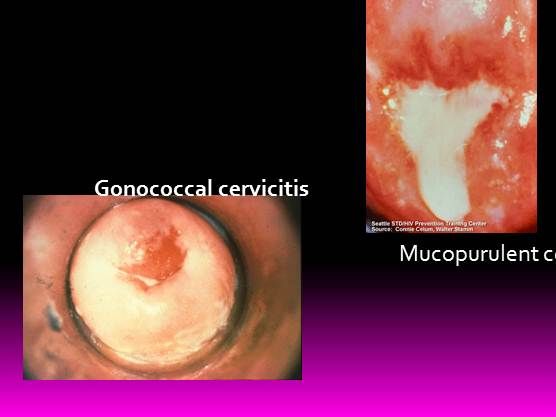
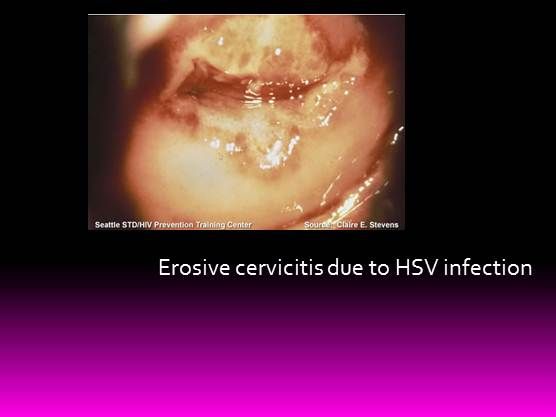
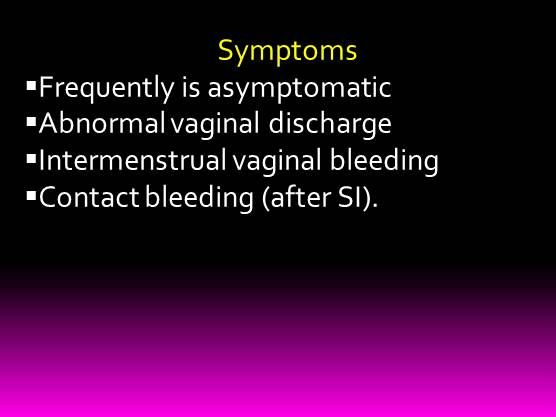
Symptoms
• Frequently is asymptomatic
• Abnormal vaginal discharge
• Intermenstrual vaginal bleeding
• Contact bleeding (after SI).
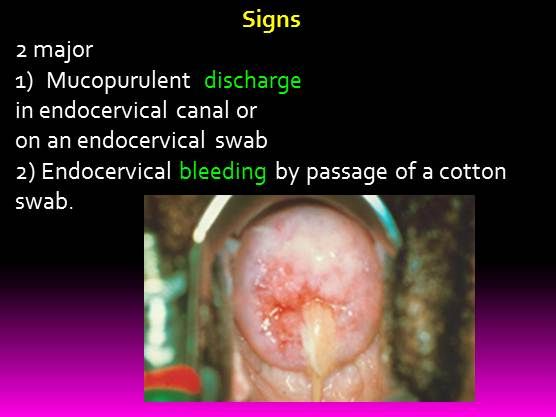
Signs
2 major
1) Mucopurulent discharge in endocervical canal or on an endocervical swab
2) Endocervical bleeding by passage of a cotton swab.
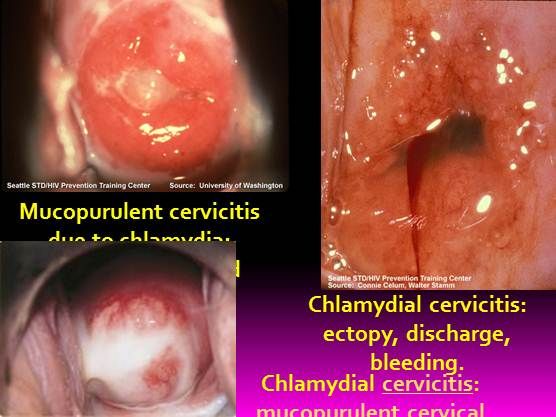
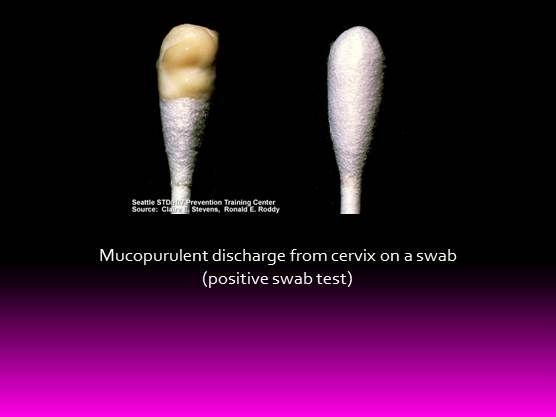
Mucopurulent discharge from cervix on a swab
(positive swab test)
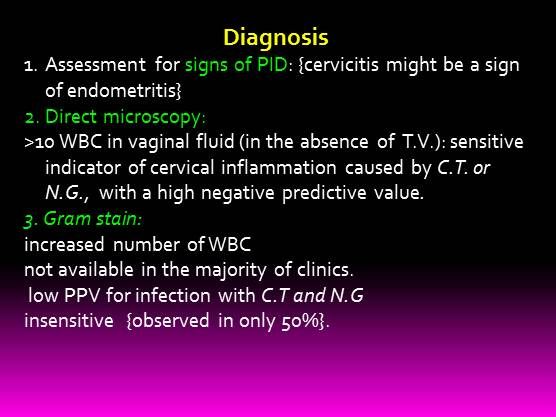
Diagnosis
1. Assessment for signs of PID: {cervicitismight be a sign of endometritis}
2. Direct microscopy: >10 WBC in vaginal fluid (in the absence of T.V.): sensitive indicator of cervical inflammation caused by C.T. or N.G., with a high negative predictive value.
3. Gram stain: increased number of WBC not available in the majority of clinics. low PPV for infection with C.T and N.G insensitive {observed in only 50%}.

3. Test for C.T and for N.G: NAAT (nucleic acid amplification tests).
4. Test for BV and TV.

TV:
• Microscopy {sensitivity is low (50%)}
• Culture or antigen-based detection: if
microscopy is negative



BV:
3 of the following S or S:
1. Homogeneous, thin, white discharge that smoothly coats the vaginal walls
2. Clue cells on microscopic examination
3. pH of vaginal fluid >4.5
4. Fishy odor of vaginal discharge before or after addition of 10% KOH (Whiff test).

5. Testing 5. for HSV-2 (culture or serologic testing): value is unclear.
6. Tests for M. genitalium: not commercially available.

Treatment
1. C. T:
a. increased risk for STD (age <25 years, new or multiple sex partners, and unprotected sex)
b. follow-up cannot be ensured
c. insensitive diagnostic test (not a NAAT) is used.
2. Concurrent therapy for N.G: if the prevalence is high (>5%).
3. T.V. or BV: if detected.

Recommended Regimens for Presumptive Treatment*
Azithromycin (Zithromax) 1 g orally in a single dose
OR
Doxycycline 100 mg orally twice a day for 7 days
•Azithromycin (Zithromax) is safe and effective during
pregnancy

Recommended Regimens of Uncomplicated Gonococcal
Infections of the Cervix, Urethra, and Rectum
Ceftriaxone 125 mg IM in a single dose
OR
Cefixime 400 mg orally in a single dose
OR
Ciprofloxacin 500 mg orally in a single dose*
OR
Ofloxacin 400 mg orally in a single dose*
OR
Levofloxacin 250 mg orally in a single dose*
PLUS
TREATMENT FOR CHLAMYDIA IF CHLAMYDIAL INFECTION IS NOT RULED OUT

BV:
Recommended Regimens
Metronidazole 500 mg orally twice a day for 7 days
OR
Metronidazole gel, 0.75%, one full applicator (5 g) intravaginally, once a day for 5 days
OR
Clindamycin cream, 2%, one full applicator (5 g) intravaginally at bedtime for 7 days
Alternative Regimens
Clindamycin 300 mg orally twice a day for 7 days
OR
Clindamycin ovules 100 g intravaginally once at bedtime for 3 days
Routine treatment of sex partners is not recommended.

TV:
Recommended Regimens
Metronidazole 2 g orally in a single dose
OR
Tinidazole 2 g orally in a single dose
Alternative Regimen
Metronidazole 500 mg orally twice a day for 7 days
Sex partners: should be treated.

Recurrent and Persistent Cervicitis
1. Exclude relapse and/or reinfection with a specific STD
2. Exclude BV
3. Sex partners: evaluated and treated
4. Repeated or prolonged administration of antibiotic therapy.
5. Ablative or superficial excisional therapy


Follow-Up
• As recommended for each infections
• If f symptoms persist, women should be instructed to return for reevaluation.

Management of Sex Partners
1. Examination.
2. Avoid SI {avoid re-infection} until therapy is completed (7 days after a single-dose regimen or after completion of a 7-day regimen).

FDA approves Visby’s test for at-home STI identification
Published: March 28th 2025 | Updated: March 28th 2025The FDA has approved Visby Medical’s at-home sexually transmitted infection test, allowing women to screen for chlamydia, gonorrhea, and trichomoniasis without a prescription.
Read More
In this episode of Pap Talk, Gloria Bachmann, MD, MSc, breaks down what it means to be a health care provider for incarcerated individuals, and explores the specific challenges women and their providers face during and after incarceration. Joined by sexual health expert Michael Krychman, MD, Bachmann also discusses trauma-informed care and how providers can get informed.
Listen
